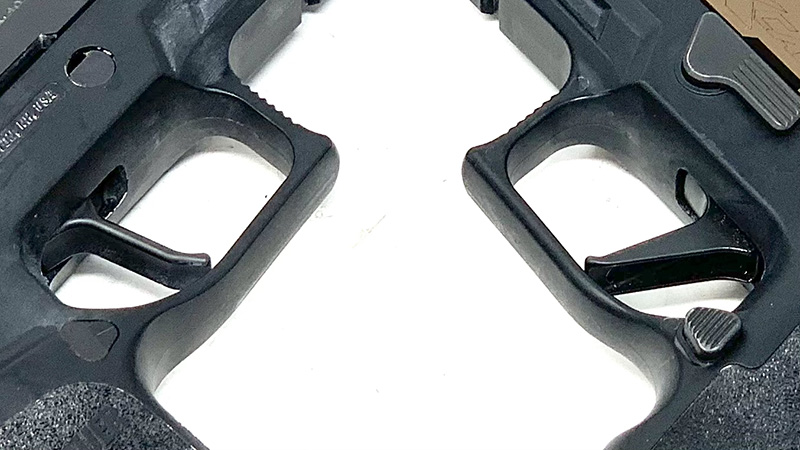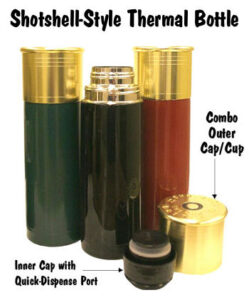If you own a Sig P320 and are looking to upgrade your trigger, you’ll most likely compare the Apex flat trigger to the Sig P320. Apex Tactical, a company that started out doing custom pistol work, is best-known for its Smith and Wesson M&P triggers. They were the first to create an aftermarket trigger for Smith and Wesson M&P. This was at a time when Smith and Wesson M&P still had a terrible factory trigger. A trigger for aftermarket use was considered a necessity. The Sig P320 did not come with a flat trigger option when it was first introduced. Sig now ships multiple models with a flat trigger. You can upgrade to the flat trigger if you own a Sig P320. The trigger can be purchased directly from Sig. We will compare the Sig P320 flat trigger vs Apex flattriggering to see how they stack up. Trigger Shoe Shape These triggers share some similarities. The angle at which they are placed is the most important similarity. Both triggers will move slightly forward. They are in the same position in the gun. The triggers are the same length from the Sig P320 grip. The width of the trigger shoes also is very similar. This is where the similarities end. Flat-Faced Sig Trigger Shoe. The Sig P320 flat trigger is much fatter if seen from the side. It extends further towards the back of your gun. It makes the trigger appear much heavier, even though it is hollowed out. It can change the way your finger touches the trigger face and the feel of the trigger. Although the trigger edges are smoother, there is still a slight sharpness to it. This is not an issue for me as my trigger finger contacts the trigger shoe in the middle. These edges might be uncomfortable for those with shorter or longer fingers. The trigger shoe also has a hook at its bottom. The hook is very small and will not cause discomfort for people with larger hands. My trigger finger doesn’t touch the hook because it isn’t how it impacts the trigger’s trigger’s face. Apex Flat-Faced Trigger Shoe. The Apex trigger’s trigger shoe is narrower. It’s thinner when viewed from the side. It also has more rounding at the trigger shoe’s edges. If you have larger hands, you will find that the trigger pad of your finger is placed more to the side. This trigger may be slightly less comfortable than the Sig’s trigger shoe. The hook at the bottom is another thing to note. This hook extends higher up the Apex trigger that it does on Sig trigger. It is there for me personally. It makes the trigger feel more flexible than a flat-faced trigger. It’s more like an angled trigger. It doesn’t bother my, but it’s not something that I love. I prefer the Sig P320 flat trigger to the Apex. Trigger Takeup: This is something that many people will care about. Some people prefer a quick take-up. Some prefer a longer take-up, which allows them to make mistakes. Sig The Sig P320 has a very low take-up. It will be filled as soon as you place the trigger. It is only about a tenth of an inch. It’s not much. Apex The trigger take up on the Sig P320 Apex trigger trigger is even lower than that of the Sig P320 factory trigger. This take-up is very minimal, perhaps half a tenth of an inch. This seems very small. It is. Once you reach that point, you will feel a solid wall. Trigger Break This is where you will notice the difference between the two designs. Sig After you have removed the take-up from the Sig P320 flat-faced trigger you will feel the slightest creep. Then it will transition into a rolling break. This break is very subtle. You’ll feel the creep if you pull the trigger slowly. However, the trigger has a nice rolling break. I love a rolling trigger break. The Sig P320 trigger is very comfortable to me. Apex The Apex trigger will feel a bit creepy. The stock Sig P320 trigger will feel more creepy than the Apex. The Apex trigger is almost completely silent when you are pressed against a wall. The trigger will almost instantly stop working once you have filled the wall. It snaps like an apple. It’s not quite as glass breaking, but it is still a carrot break. This Apex Sig P320 flat-faced trigger has a solid wall. Reset These triggers also have different resets. The most noticeable difference between these triggers is the trigger break and reset. Sig The factory flat-faced trigger of the Sig P320 will give you a very mushy reset. The trigger resets slightly in the take-up zone. It resets directly in front of the area you will feel right after take-up. Apex Your reset will be in the exact same place as the Sig factory trigger. It will feel more authoritative, with the only difference being that it will be almost identical to the Sig factory trigger. These triggers have a very soft reset but the Apex feels more definite once it resets. The Apex will make a solid click. The click on the Sig trigger will also be heard, but it will not feel as positive as the Apex trigger. Both triggers are priced at $50. The Apex will cost $50 more if you have a Sig model that has a flat-face trigger. Unless your gun has a factory Sig flat face trigger, the price of the trigger will not make a difference. For me, the extra cost is not worth it. Final Thoughts: I prefer the rolling break of the Sig trigger, while Michael of Lynx Defense prefers the more precise characteristics of the Apex trigger. The Sig P320 flat-face trigger is for you if you prefer a rolling brake. The Apex is for you if you prefer a decisive brake. Both triggers are excellent. You can’t go wrong with either one of these triggers, but you shouldn’t expect a 1911-quality trigger from either one. Like this:Like Loading…

Offers of the Week on DealFinder 508: AccurateShooter
June 16th, 2025BargainFinder 508: AccurateShooter’s Talks of the WeekAt the demand of our readers, we offer a few” Talks of the Week” options. Our Best Discount choices are available every
















